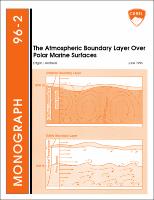Please use this identifier to cite or link to this item:
https://hdl.handle.net/11681/2647| Title: | The atmospheric boundary layer over polar marine surfaces |
| Authors: | National Science Foundation (U.S.) United States. Office of Naval Research Andreas, Edgar L. |
| Keywords: | Air–sea–ice interactions Cold regions Meteorology Polar meteorology Atmospheric boundary layer Polar marine surfaces Turbulence EPOLAR |
| Publisher: | Cold Regions Research and Engineering Laboratory (U.S.) Engineer Research and Development Center (U.S.) |
| Series/Report no.: | CRREL monograph ; 96-2 |
| Description: | CRREL Monograph Abstract: The Atmospheric Boundary Layer (ABL) over polar marine surfaces is, in ways, simpler and, in other ways, more complex than ABLs in other environments. It is simpler because topographic effects are rarely a concern, the surface is fairly homogeneous, and roughness lengths over sea ice and the ocean are much smaller than they are over land. It is complex because the stratification is usually stable, and stable ABLs have not yielded to quantification as readily as convective ABLs have. This report reviews some of these characteristics of ABLs over polar marine surfaces. The ABL, by definition, is the turbulent layer between the Earth’s surface and the (generally) nonturbulent free atmosphere. Hence, the emphasis is on turbulence processes—in particular, the turbulent transfer of momentum and sensible and latent heat over sea ice. As such, this report reviews both the theoretical and observational bases for our understanding of the mean structure of the ABL. Understanding this structure then allows predicting the turbulent surface fluxes of momentum and sensible and latent heat. |
| Rights: | Approved for public release; distribution is unlimited. |
| URI: | http://hdl.handle.net/11681/2647 |
| Appears in Collections: | Monograph |
Files in This Item:
| File | Description | Size | Format | |
|---|---|---|---|---|
| CRREL-Monograph-96-2.pdf | 705.86 kB | Adobe PDF |  View/Open |